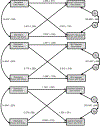Perceptions of function and recovery among persons with stroke and care partners
- PMID: 35377699
- PMCID: PMC10131190
- DOI: 10.1037/rep0000441
Perceptions of function and recovery among persons with stroke and care partners
Abstract
Purpose/objective: Perceptions of function can differ between persons with stroke and care partners. The current study described the frequency of discrepancy in ratings of poststroke functioning across romantic partners and examined associations between perceptions of function, depressive symptoms, and caregiver strain.
Research method/design: A secondary analysis was conducted using data from the baseline visit of an intervention pilot study. Twenty-nine dyads completed measures of perceived current functioning of the person with stroke (Stroke Impact Scale 3.0: overall percent recovery, ADL, and cognition), self-reported ratings of depressive symptoms for both partners (PROMIS Depression Short Form v8b), and self-reported caregiver strain for the care partners only (Caregiver Strain Index).
Results: A discrepancy of over 10 points on the SIS 3.0 variables was seen in over 50% of dyads for all subscales, with care partners rating worse recovery on average. Actor partner interdependence models showed that more depressive symptoms were associated with perceptions of worse overall recovery and ADL function in persons with stroke, whereas more depressive symptoms were associated with perceptions of worse cognitive and ADL function in care partners. Discrepancy in perception of ADL function was associated with more caregiver strain though this was inextricable from the overall level of impairment in ADL function perceived by the care partner.
Conclusions/implications: These findings suggest that discrepancy in perceptions of stroke recovery among romantic partners is common. This underscores the importance of perception when considering risk for depression and caregiver strain as well as how to best promote psychological resilience following stroke. (PsycInfo Database Record (c) 2022 APA, all rights reserved).
Trial registration: ClinicalTrials.gov NCT03335358.
Conflict of interest statement
Figures


References
-
- Bakas T, Clark PC, Kelly-Hayes M, King RB, Lutz BJ, & Miller EL (2014). Evidence for stroke family caregiver and dyad interventions a statement for healthcare professionals from the American Heart Association and American Stroke Association. Stroke, 45, 2836–2852. 10.1161/STR.0000000000000033/-/DC1 - DOI - PubMed

